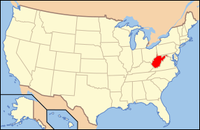| ||||||||||||||
| Hardy County, West Virginia | |
 Location in the state of West Virginia | |
 West Virginia's location in the U.S. | |
| Founded | 1785 |
|---|---|
| Seat | Moorefield |
| Area - Total - Land - Water |
584 sq mi (1,513 km²) 583 sq mi (1,510 km²) 1 sq mi (3 km²), 0.19% |
| Population - (2010) - Density |
14,025 21/sq mi (8/km²) |
Hardy County is a county located in the U.S. state of West Virginia. As of 2010, the population was 14,025. Its county seat is Moorefield[1]. Hardy County was created from Hampshire County in 1786 and named for Samuel Hardy, a distinguished Virginian.
Geography
Through this county flows the South Branch Potomac River with its surrounding magnificent valley. Several miles wide, "the Valley," as it is commonly called, contains lands whose fertility lends itself to successful farming. Agriculture and stock raising have always been the main source of employment in this area, with corn, wheat, apples, peaches, melons, cattle and poultry having important interests. Truck-farming has a vital role, each household possessing its own small garden.
On either side of the Valley are high mountains with rough terrain and heavy timber. Throughout the area wildlife is plentiful, and hunting has always been a major diversion and source of meat supply. In the winter snows are whipped by winds of gale force, and snowdrifts are usually numerous.
The South Branch is a clear stream, quite wide, and of considerable depth in many places. Watering the Valley, the river abounds in fish and creates many picturesque settings. At times the usually calm waters surge from low banks and spread over the Valley, enveloping and ravishing the rich surrounding lands. The river has a peculiar feature in the field of geology as it flows through the Valley. At one point the river, thousands of years ago, did not cut across the mountains from one side to the other, but made a passage through them from end to end. This geological exception is now in the form of a narrow, trough-like gap, about seven miles (11 km) long, and appropriately called "The Trough". At the present day, the gorge is several hundred feet deep, and the South Branch flows in a narrow channel at the bottom, with almost perpendicular walls of rock on either side.
In the very center of the South Branch Valley, surrounded by high mountains, and located on the east side of the junction of the South Fork South Branch Potomac River and the South Branch Potomac, is Moorefield, the county seat of Hardy County. A quiet farming center in 1860, the population of the Moorefield area at that time was about 1,500. At this period there were no bridges at Moorefield, and the South Branch had to be forded some three miles (5 km) up the Valley, or the ferryboat, which was usually busy, had to be used. The main towns that communicated with Moorefield were Petersburg, Romney, and New Creek (presently Keyser) the latter having a stage line between the two points.
History
Hardy County had a rich African American history, with many free African Americans living there before the Civil War. This history is discussed in part 2 of the Henry Louis Gates television series African American Lives.
Geography
According to the U.S. Census Bureau, the county has a total area of 584 square miles (1,512.6 km2), of which 583 square miles (1,510.0 km2) is land and 1 square mile (2.6 km2) (0.19%) is water.
Major highways
U.S. Highway 220
West Virginia Route 28
West Virginia Route 29
West Virginia Route 55
West Virginia Route 259
- U.S. Highway Route 48
Adjacent counties
- Hampshire County (north)
- Frederick County, Virginia (east)
- Shenandoah County, Virginia (southeast)
- Rockingham County, Virginia (south)
- Pendleton County (southwest)
- Grant County (west)
National protected area
- George Washington National Forest (part)
Demographics
| Historical populations | |||
|---|---|---|---|
| Census | Pop. | %± | |
| 1790 | 7,336 | ||
| 1800 | 6,627 | −9.7% | |
| 1810 | 5,525 | −16.6% | |
| 1820 | 5,700 | 3.2% | |
| 1830 | 6,798 | 19.3% | |
| 1840 | 7,622 | 12.1% | |
| 1850 | 9,543 | 25.2% | |
| 1860 | 9,864 | 3.4% | |
| 1870 | 5,518 | −44.1% | |
| 1880 | 6,794 | 23.1% | |
| 1890 | 7,567 | 11.4% | |
| 1900 | 8,449 | 11.7% | |
| 1910 | 9,163 | 8.5% | |
| 1920 | 9,601 | 4.8% | |
| 1930 | 9,816 | 2.2% | |
| 1940 | 10,813 | 10.2% | |
| 1950 | 10,032 | −7.2% | |
| 1960 | 9,308 | −7.2% | |
| 1970 | 8,855 | −4.9% | |
| 1980 | 10,030 | 13.3% | |
| 1990 | 10,977 | 9.4% | |
| 2000 | 12,669 | 15.4% | |
As of the census[2] of 2000, there were 12,669 people, 5,204 households, and 3,564 families residing in the county. The population density was 22 people per square mile (8/km²). There were 7,115 housing units at an average density of 12 per square mile (5/km²). The racial makeup of the county was 96.87% White, 1.93% Black or African American, 0.16% Native American, 0.14% Asian, 0.23% from other races, and 0.67% from two or more races. 0.66% of the population were Hispanic or Latino of any race.
There were 5,204 households out of which 29.60% had children under the age of 18 living with them, 56.10% were married couples living together, 8.60% had a female householder with no husband present, and 31.50% were non-families. 27.00% of all households were made up of individuals and 12.20% had someone living alone who was 65 years of age or older. The average household size was 2.42 and the average family size was 2.92.
In the county, the population was spread out with 23.30% under the age of 18, 7.60% from 18 to 24, 28.80% from 25 to 44, 25.40% from 45 to 64, and 14.90% who were 65 years of age or older. The median age was 39 years. For every 100 females there were 97.50 males. For every 100 females age 18 and over, there were 96.70 males.
The median income for a household in the county was $31,846, and the median income for a family was $37,003. Males had a median income of $28,032 versus $18,798 for females. The per capita income for the county was $15,859. About 10.50% of families and 13.10% of the population were below the poverty line, including 13.10% of those under age 18 and 20.20% of those age 65 or over.
Cities and towns
Incorporated towns
- Town of Moorefield
- Town of Wardensville
Unincorporated communities
|
|
|
|
|
See also
- Lost River State Park
- National Register of Historic Places listings in Hardy County, West Virginia
- South Branch Wildlife Management Area
References
- ^ "Find a County". National Association of Counties. http://www.naco.org/Counties/Pages/FindACounty.aspx. Retrieved 2011-06-07.
- ^ "American FactFinder". United States Census Bureau. http://factfinder.census.gov. Retrieved 2008-01-31.
External links

|
Hampshire County | 
| ||
| Grant County | Frederick County, Virginia | |||
 Hardy County, West Virginia | ||||
| Pendleton County | Rockingham County, Virginia | Shenandoah County, Virginia |
| ||||||||||||||
| |||||||||||
| ||||||||||||||||||||
| This page uses content from the English language Wikipedia. The original content was at Hardy County, West Virginia. The list of authors can be seen in the page history. As with this Familypedia wiki, the content of Wikipedia is available under the Creative Commons License. |
